The philosophy and psychology and symbols that inform, constrain and liberate (corporate) culture.
THE HERO’S JOURNEY (WHICH IS BOTH PERSONAL AND COLLECTIVE)
THE LEADERSHIP STYLES FOR DIFFERENT CULTURES
EXPLORING THE CULTURAL COMPLEX
INTRODUCTION
GoTop
As a Coach I am always learning. Partly formally through participation in courses, a lot through reading and book clubs and practically from the thinking partnerships that I have in my coaching conversations.
There is stuff that is unique and different, but there are also topics and ways of thinking, feeling and being that are timeless and straddle philosophy and psychology, apparently being cultural of our time, place, circumstance and interesting for a deeper examination of corporate culture and its impact.
I’d like to explore some of these, offer some observations and invite feedback, comment and contribution.
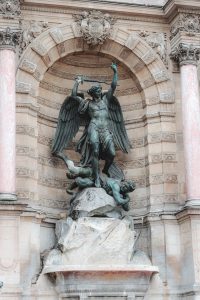
CULTURE
GoTop
An easy definition of Culture is set of patterns of human activity within a community or social group and the symbolic structures that give significance to such activity. Customs, laws, dress, architectural style, social standards and traditions are all examples of cultural elements.
But where do these come from and to what extend do they shape us, or do we shape them, or indeed how malleable are they?
CORPORATE CULTURE
GoTop
Corporate culture, also known as company culture, refers to a set of beliefs and behaviors that guide how a company’s management and employees interact and handle external business transactions. Corporate culture can have a huge impact on the fortune of a company and its employees.
I find it interesting how business often rebrand, have new mission, vision, values, objectives and purpose. What does it say when we change these elements so often, or indeed articulate new words, new vision, but stick to old habits and past practices.
THE MBA GUIDE TO CULTURE
GoTop
I remember from my MBA the Cultural Web, developed by Gerry Johnson and Kevan Scholes in 1992, which provides one such approach for looking at and changing your organization’s culture. Using it, you can expose cultural assumptions and practices, and set to work aligning organizational elements with one another, and with your strategy.
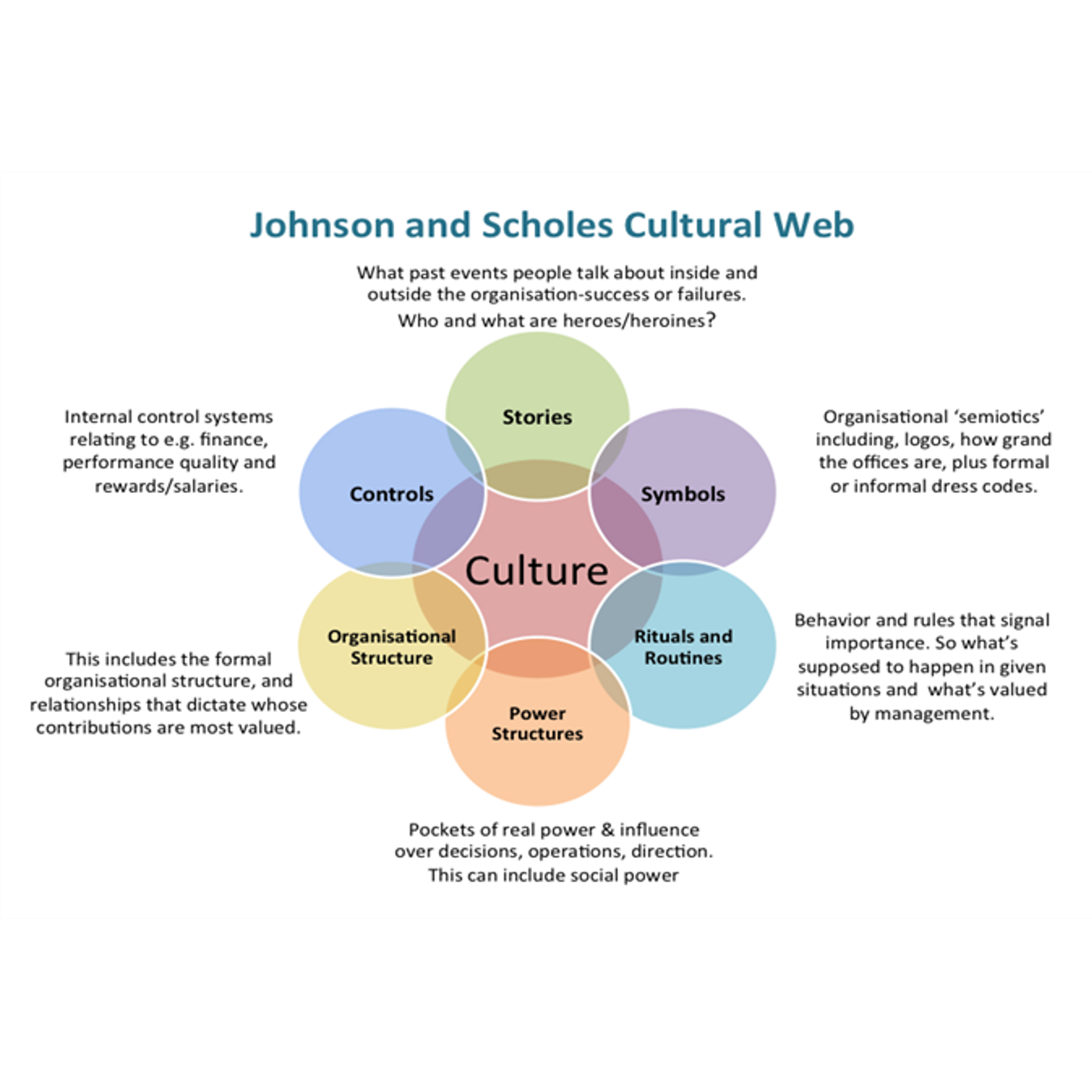
Their six elements are:
1. Stories – The past events and people talked about inside and outside the company. Who and what the company chooses to immortalize says a great deal about what it values, and perceives as great behavior.
2. Rituals and Routines – The daily behavior and actions of people that signal acceptable behavior. This determines what is expected to happen in given situations, and what is valued by management.
3. Symbols – The visual representations of the company including logos, how plush the offices are, and the formal or informal dress codes.
4. Organizational Structure – This includes both the structure defined by the organization chart, and the unwritten lines of power and influence that indicate whose contributions are most valued.
5. Control Systems – The ways that the organization is controlled. These include financial systems, quality systems, and rewards (including the way they are measured and distributed within the organization).
6. Power Structures – The pockets of real power in the company. This may involve one or two key senior executives, a whole group of executives, or even a department. The key is that these people have the greatest amount of influence on decisions, operations, and strategic direction.
This recognises and codifies culture but it does not explain the source, which lies somewhere in philosophy (myth) and psychology (neurobiology) and is explored in the writing of Carl Jung, and finds itself mapped in Gabor Mate’s work on Trauma and Child Development and commonly portrayed in every Hollywood movie with the archetypal hero’s journey.
THE HERO’S JOURNEY (WHICH IS BOTH PERSONAL AND COLLECTIVE)
GoTop
In The Hero with a Thousand Faces, Joseph Campbell, a professor of literature at Sarah Lawrence College, unpacks his theory that all mythological narratives share the same basic structure. Here are all 17 steps of the hero’s journey, as outlined by Campbell:
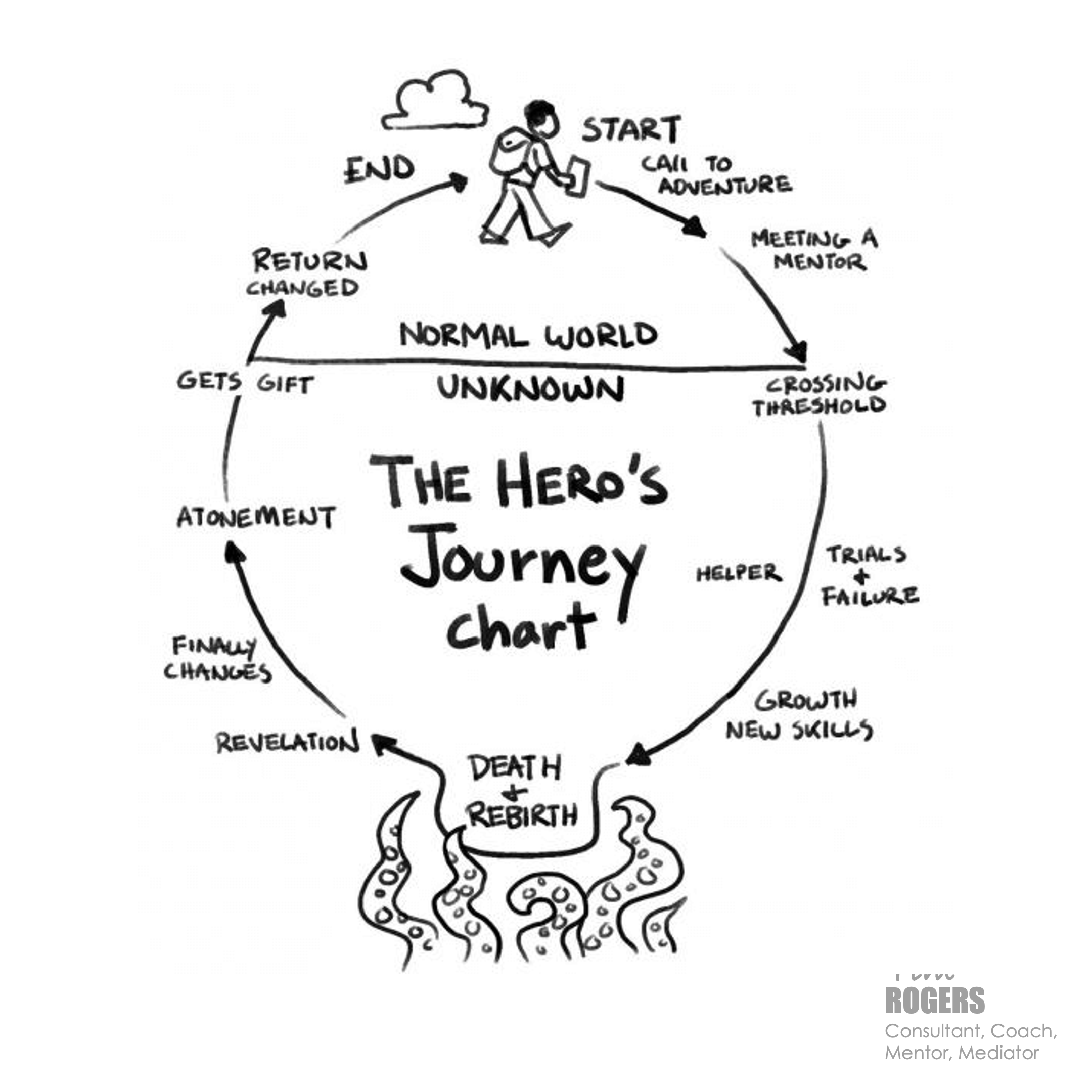
Departure
1. The call to adventure: Something, or someone, interrupts the hero’s familiar life to present a problem, threat, or opportunity.
2. Refusal of the call: Unwilling to step out of their comfort zone or face their fear, the hero initially hesitates to embark on this journey.
3. Supernatural aid: A mentor figure gives the hero the tools and inspiration they need to accept the call to adventure.
4. Crossing the threshold: The hero embarks on their quest.
5. Belly of the whale: The hero crosses the point of no return, and encounters their first major obstacle.
Initiation
6. The road of trials: The hero must go through a series of tests or ordeals to begin his transformation. Often, the hero fails at least one of these tests.
7. The meeting with the goddess: The hero meets one or more allies, who pick him up and help him continue his journey.
8. Woman as temptress: The hero is tempted to abandon or stray from his quest. Traditionally, this temptation is a love interest, but it can manifest itself in other forms as well, including fame or wealth.
9. Atonement with the father: The hero confronts the reason for his journey, facing his doubts and fears and the powers that rule his life. This is a major turning point in the story: every prior step has brought the hero here, and every step forward stems from this moment.
10. Apotheosis: As a result of this confrontation, the hero gains a profound understanding of their purpose or skill. Armed with this new ability, the hero prepares for the most difficult part of the adventure.
11. The ultimate boon: The hero achieves the goal he set out to accomplish, fulfilling the call that inspired his journey in the first place.
Return
12. Refusal of the return: If the hero’s journey has been victorious, he may be reluctant to return to the ordinary world of his prior life.
13. The magic flight: The hero must escape with the object of his quest, evading those who would reclaim it.
14. Rescue from without: Mirroring the meeting with the goddess, the hero receives help from a guide or rescuer in order to make it home.
15. The crossing of the return threshold: The hero makes a successful return to the ordinary world.
16. Master of two worlds: We see the hero achieve a balance between who he was before his journey and who he is now. Often, this means balancing the material world with the spiritual enlightenment he’s gained.
17. Freedom to live: We leave the hero at peace with his life.
To what extend does Hollywood and Social Media shape the narrative of our lives by the reinforcement of the archetypal hero’s journey and the myths and fables of our youth and ancestors? I think understanding the hero’s journey is useful for anyone in change management who wants to understand (as possibly orchestrate) the roles, thinking, expectation and anticipation of people going through their journeys.
KÜBLER-ROSS MODEL
GoTop
The archetypal hero’s journey seems a more interesting alternative to the stages outlined in the Change Curve which is often applied to businesses.
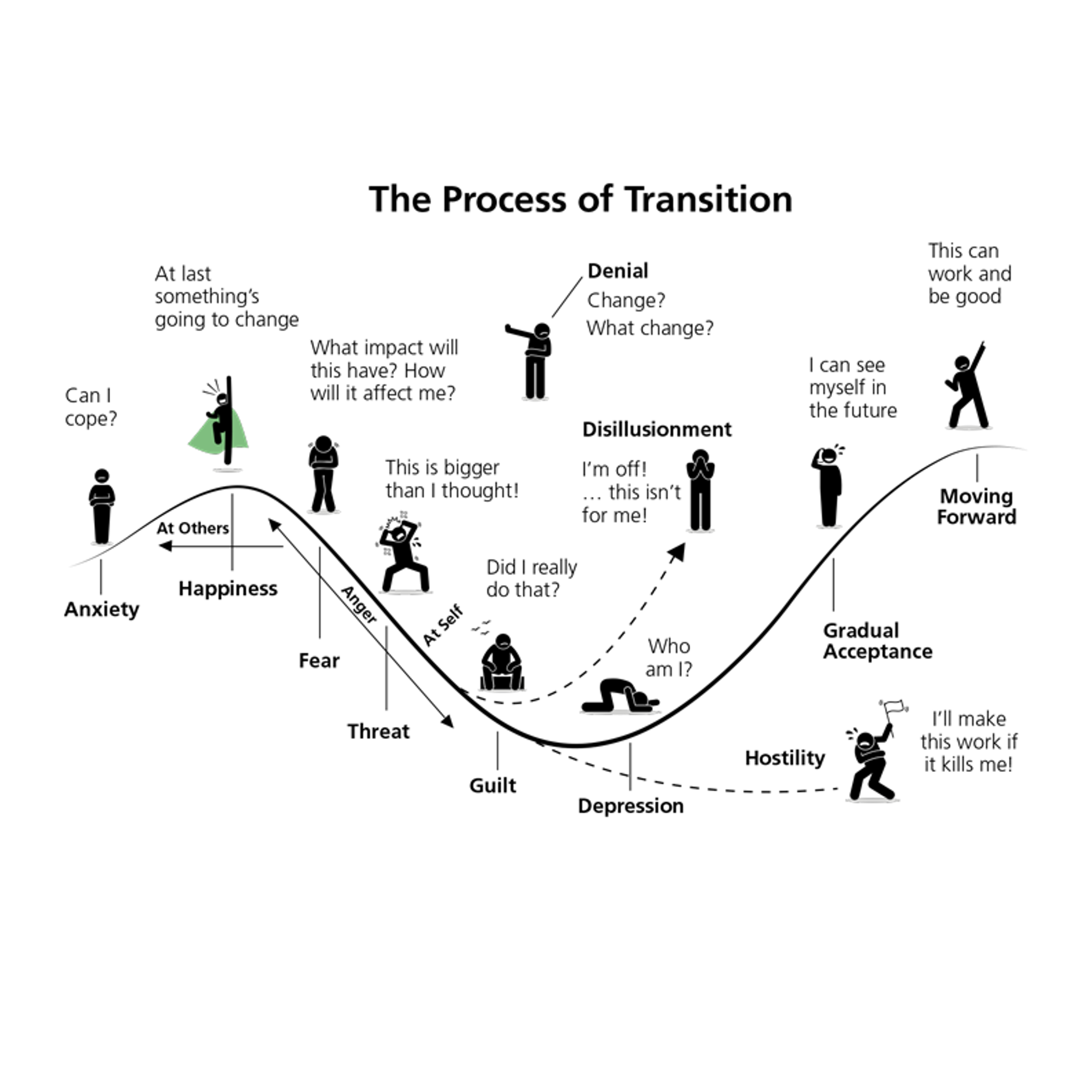
The five stages of grief model (or the Kübler-Ross model) is popularly known as a model that describes a series of emotions experienced by people who are grieving: denial, anger, bargaining, depression and acceptance. In actuality, the Kübler-Ross model was based on people who are dying rather than grieving.
1. Denial
The first stage is shock or denial, and an individual puts forward their defense mechanisms to deflect the actual occurrence of the change. There is a steep decline in employee productivity in this stage, as it’s only human to cling to past processes or individual expectations, leading to a disconnect with reality.
2. Anger
When the reality of change sinks in, it’s manifested in the form of fear or anger. Any change initiative has the potential to spiral out of control in this stage, resulting in significant change failures.
3. Bargaining
Once an individual crosses the anger stage of the change curve, they attempt to salvage the situation by exploring the path of least objection. They may try to negotiate and find a compromise.
4. Depression
In the depression stage, a person loses hope entirely. There are signs of extreme sadness, regret, and demotivation.
5. Acceptance
In the final stage of the change curve, individuals come to terms with the change. Their inhibitions are lowered, they accept the change, and start to explore new favorable opportunities that are a result of the change.
You may be able to see parallels between the Kübler-Ross model and the hero’s journey, and that is the point. These symbols, models, myths and beliefs are embedded within us. They are so often the scripts, narratives and stories that we use to navigate our lives and therefore provide a useful map for anyone who wants to influence that navigation.
THE LEADERSHIP STYLES FOR DIFFERENT CULTURES
GoTop
I remember from my MBA the Goleman’s 6 leadership styles and when to apply them, party to acknowledge the people, market, imperatives that suggest different leadership styles are needed in different circumstances.
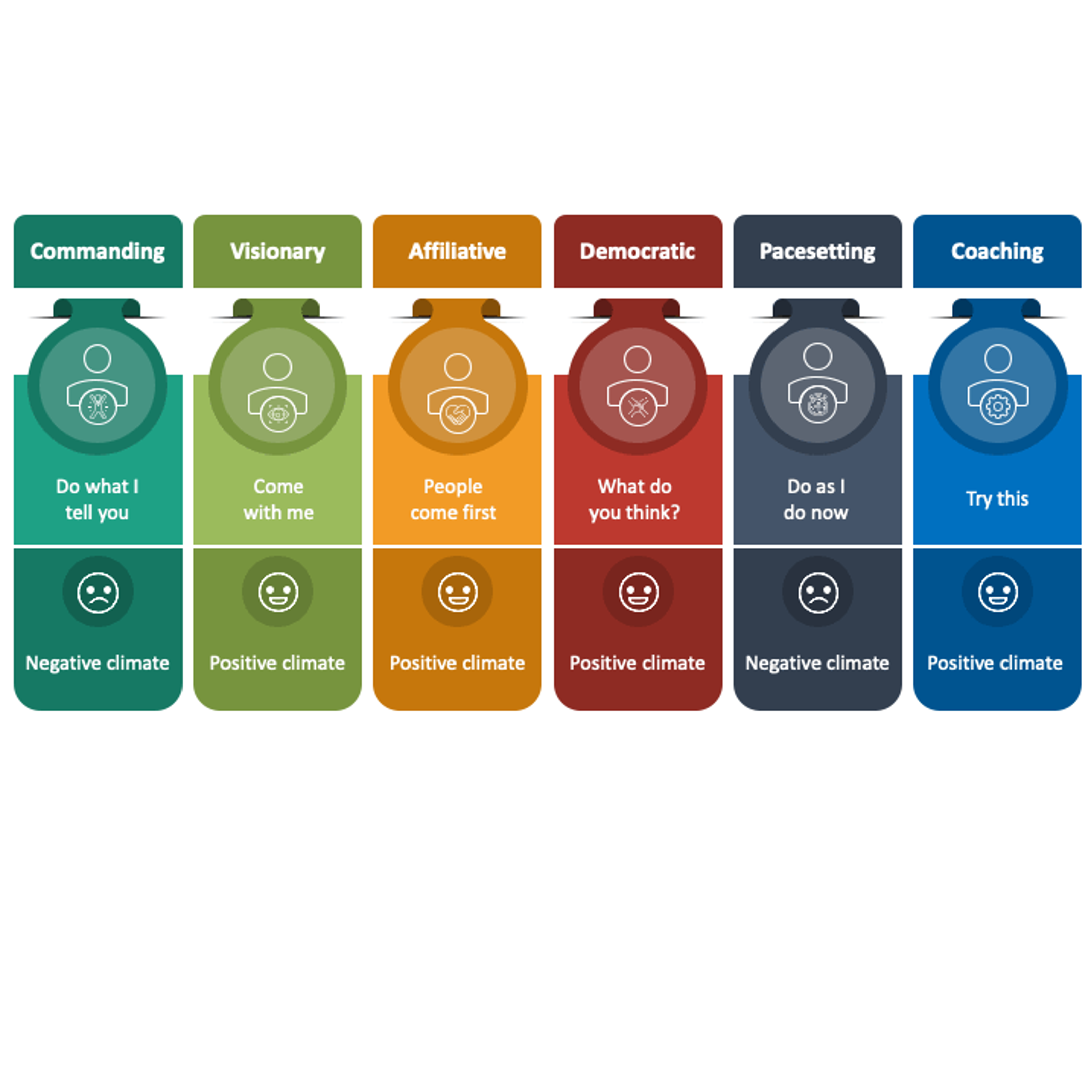
1. The visionary leader
The visionary leadership style creates momentum toward a shared vision. This style is about getting your team aligned towards their North Star. When should you apply it: Adopt this style when the requirement for direction becomes extremely urgent.
2. The coaching leader
Coaching leaders adopt a coaching mentality to help develop the skill set of their employees and encourage them to shine their strengths by living out their potential. Part of being a coach is helping others to evolve into their role, feel challenged and supported. When should you apply it: especially in growing teams, as work gets more complex, you’ll team will need more than clear objectives. They will need your encouragement to grow their skills and abilities so that they grow confidence in their ability to perform.
3. The affiliative leader
Affiliative leadership happens when a leader feels comfortable building connections throughout the company. The focus is to create a harmonious workplace, one where employees can feel as though they have achieved team chemistry and a level of comfort with one another. When should you apply it: if you sense a lack of connection between teams. This style is very important in a remote work context, where we could easily work in silos and find ourselves disconnected from what is going on.
4. The democratic leader
In democratic leadership, the manager knows how to collaboratively implement inclusive next steps and focuses on building healthy progress for everyone, at all levels. When should you apply it: This approach is helpful in situations where everyone’s input is required to support decisions and strategic planning that will affect the whole team.
5. The pacesetting leader
A pacesetting leader focuses on concrete goals that are set for their team. Pacesetting leaders have high expectations of the team and are fast-paced in their demands. They should balance their high-intensity leadership with a strong recognition plan.When should you apply it: this style is most effective with short-term goals. It’s wise to first address if this level of pressure is conducive to the success of your team.
6. The commanding leader
Simply put, this leadership behavior promotes a fear based mentality. This approach can come across as harsh and typically leaves a negative footprint on a company’s culture. To say it bluntly, those who lead with fear are regarded as ineffective. It’s generally recommended to avoid using this style altogether unless it is in a state of emergency when you need to quickly make decisions, even if they are unpopular.
The advice to leaders is either find an organisation that demands your leadership style or adapt your leadership style to the organisation. It is about finding or making a role that fits the current circumstance, in essence that is fitting with the narrative, the plot, the story.
THE 12 CHARACTER ARCHETYPES
GoTop
We can see in these leadership styles and many of the Hollywood movie and myths that preceded them re archetype roles which have existed as long as humanity.
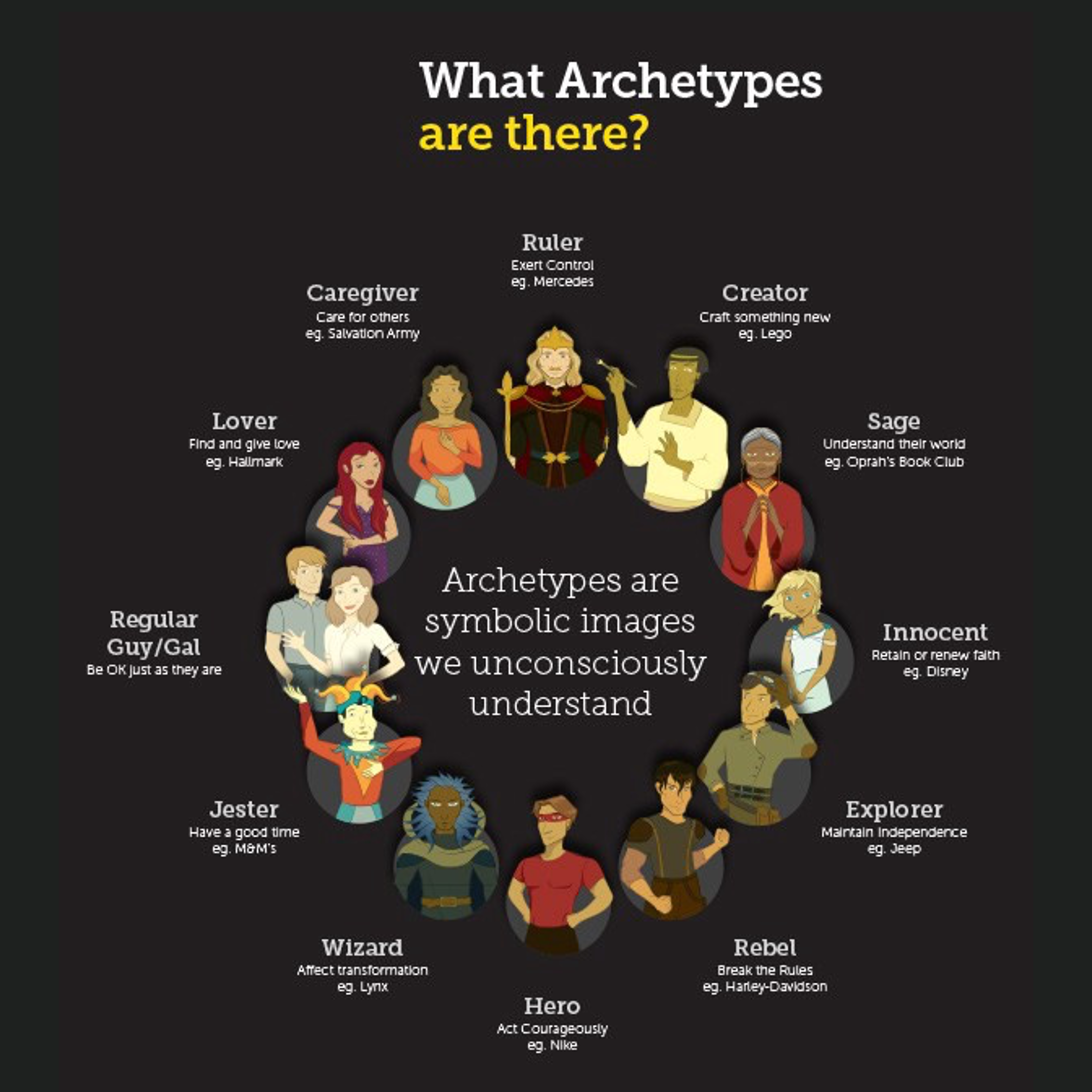
1. The Innocent
Often a child, this archetypal character is someone who sees the world as a good and wholesome place… until something happens to change their perspective. As they go through the story, this character type will learn some tough lessons about the world, and do some growing up.
2. The Orphan
While this archetypal character doesn’t literally need to be an orphan, they’re often looking for a new family. Orphans make great protagonists because they’ve got a lot to gain if the story goes in their favour. Usually, they’re a regular person that’s snatched from obscurity, becoming the main character in the story.
3. The Hero
Sometimes known as the warrior, this stock character is the person you put in your story to crush the enemy and save the day. While they might suffer from a crisis of confidence along the way, they’ll rise once more like a phoenix from the ashes, and complete the hero’s journey. They’re the man or woman with a plan.
4. The Caregiver
The caregiver takes many forms – parent, spouse, best friend – and you can rely on them to do their best to protect their child, lover, or friend. Sometimes they play an active sidekick role, while other times they’re mostly in the background.
5. The Seducer
These beautiful, irresistible character types use their good looks and irrepressible charm to spin every situation. They come in every shape, size, and gender, and offer power, sex, money, and influence to get what they want. However, anything on offer usually comes with a high price.
6. The Rebel
The rebel character type is a person who won’t settle for the status quo. They have a strong sense of justice, and they’ll do whatever it takes to make things fair. They’re not always natural leaders – some appear as a kind of everyman anti-hero – but they sure know how to shake things up.
7. The Lover
This character archetype will do anything for love. Their heart is firmly on their sleeve, and they’re utterly devoted to the object of their affection – sometimes at the expense of their own safety. The lover makes for a great protagonist in a story… but their journey often ends in tragedy.
8. The Creator
For these creative wizards, the most important thing is making things. Sometimes the creator is a classic artist type, but they can also appear as more of a business guru. They can be a bit of a loner, sacrificing anything – friends, family, themselves – in their quest to build something that leaves a mark.
9. The Joker
Predictably, the joker is out for a laugh and a good time. They play the fool and don’t take life too seriously. In times gone by, the joker (then called the jester) might serve as a sage in disguise – offering wise words, masked by humour. Nowadays, the joker character in a film is likely to be there simply as light relief.
10. The Mentor
Everyone needs a mentor, even a superstar protagonist. Sometimes called a sage, the mentor appears to guide your protagonist, preparing them for the journey ahead. They can be a parent, friend, or simply any wise old man with a long beard.
11. The Magician
Forget cute old men in silk shirts pulling rabbits out of hats – the magician character archetype can be a lot more sinister. Much like the mentor, they seek enlightenment and wisdom. However, the magician also wants to impose their wishes on the world around them. This trickster’s skills are often far beyond what people can understand.
12. The Ruler
This personality type loves to be in control. While they might not wear a literal crown, they certainly wear a figurative one. Their goal is to stay on top. Some ruler characters do this with kindness, while others are much more dictatorial.
We all recognise these roles or versions of them: we cast ourselves and others in the roles that suit our personal stories. This is a richer and more complex version of the Drama Triangle (discussed next), and useful to understand how we see ourselves and others, and how we relate or transact accordingly.
I use the word transact to link to Transactional Analysis (TA) which is a psychoanalytic theory and method of therapy wherein social interactions (or “transactions”) are analyzed to determine the ego state of the communicator (whether parent-like, childlike, or adult-like) as a basis for understanding behaviour.
THE DRAMA TRIANGLE
GoTop
The Drama Triangle was first described by Stephen Karpman in the 1960s. It is a model of dysfunctional social interactions and illustrates a power game that involves three roles: Victim, Rescuer, and Persecutor, each role represents a common and ineffective response to conflict.
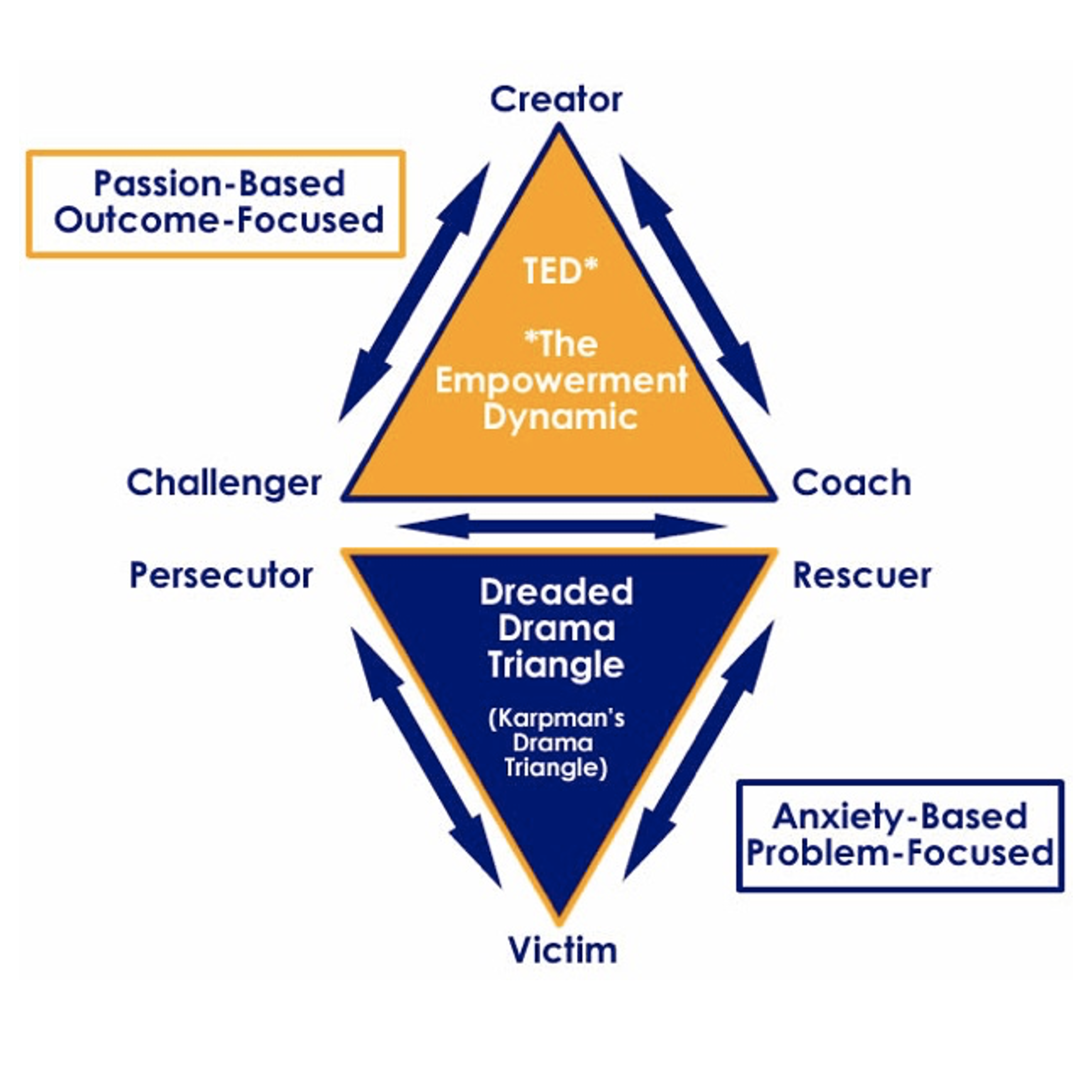
EXPLORING THE CULTURAL COMPLEX
GoTop
The theory of cultural complexes emerges as a way of understanding Carl Jung’s collective psyche as it expresses itself in group behavior and individual psychological experience.
Common characteristics of ‘cultural complexes’ include their unconsciousness, their resistance to consciousness, their autonomous functioning, their repetitive occurrence in a group’s experience from generation to generation, and their tendency to accumulate historical experiences and memory that validate their point of view.
Jung’s cultural complex idea offers a view of the forces that prevent human attempts to bring a peaceful, collaborative spirit to conflict between groups. The unconsciousness of the collective leads us to “sleep-walk” into roles and situations without conscious thought or deliberation.
The conflict between ‘the West’ and ‘Islam’ is explored as an example of a cultural complex, which may also be explore through Spiral Dynamics (discussed next)
This seems highly relevant to understanding change.
SPIRAL DYNAMICS
GoTop
Spiral Dynamics is a model and language which describes the development of people, organisations and society. It helps us understand the value systems (what they care about and what motivates them) of different people and organisations, as they move through distinct stages of development
Based on the theory of psychology professor Clare W. Graves identified eight development stages, each with its own value system fulfilling its own function in a particular context. Every stage is represented by a particular color and is categorized as either a first-tier or second-tier meme.
Individuals, organizations, societies, and cultures do not operate exclusively on one level. Instead, each embodies multiple value systems to varying degrees. The spiral dynamics model also posits infinite stages of progression and regression over time because of the fluid nature of life experience.
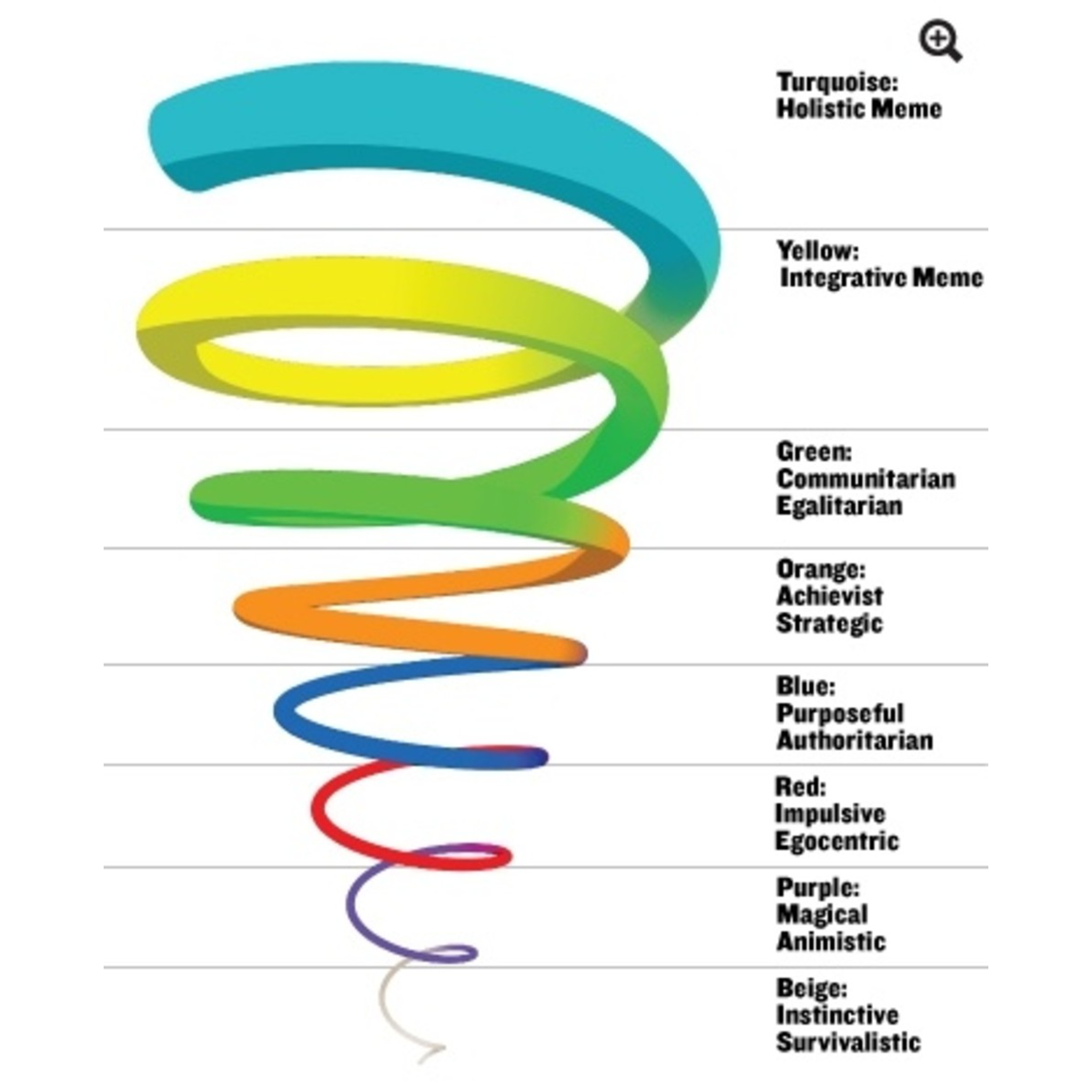
First tier Memes
Beige
Archaic-instinctive—survivalistic/automatic/reflexological “Express self to meet imperative physiological needs through instincts of Homo sapiens.”
Purple
Animistic-tribalistic magical-animistic “Sacrifice to the ways of the elders and customs as one subsumed in group.”
Red
Egocentric-exploitive power gods/dominionist “Express self (impulsively) for what self desires without guilt and to avoid shame.”
Blue
Absolutistic-obedience mythic order—purposeful/authoritarian “Sacrifice self for reward to come through obedience to rightful authority in purposeful Way.”
Orange
Multiplistic-achievist scientific/strategic “Express self (calculatedly) to reach goals and objectives without rousing the ire of important others.”
Green
Relativistic-personalistic—communitarian/egalitarian “Sacrifice self interest now in order to gain acceptance and group harmony.”
Second tier Memes
These are just emerging levels that gradually move away from concentration on subsistence level concerns of the First Tier toward being level existence.
Yellow
Systemic-integrative “Express self for what self desires, but to avoid harm to others so that all life, not just own life, will benefit.”
Turquoise
Holistic, A sacrifice self-interest system which is still forming
Coral
The open-ended theory suggests many more systems to come
Understanding these can help diagnosis and prognosis, and perhaps the conflict of history and culture between ‘the West’ and ‘Islam’ or indeed the differences between individuals, organizations, societies depending on “where they are operating” and between what stages they are transitioning.
You might even be able to name corporate organizations, particularly operating at Red (Egocentric), Blue (Authoritarian), or Orange (Achievist scientific/strategic) and more recently Green (communitarian/egalitarian) or possibly Yellow (Express self)
CONCLUSION
GoTop
There are a lot of models and lists here, but hopefully what is evident are the structures, symbols, rituals that inform, constrain and liberate people, communities and culture.
ABOUT THE AUTHOR
GoTop
I have more than 30 years’ experience delivering projects, programme and change and have gathered many tools, templates and tips for every type and scale of project. I love drinking coffee and exchanging ideas, so if you need anything please feel free to message me.
Follow me on a journey exploring new ideas and opportunities @timhjrogers #timhjrogers
Tim HJ Rogers
ICF Trained Coach, IoD Business Mentor, Mediator
MBA Management Consultant + Change Practitioner
Mob 447797762051 Tim@ThinkingFeelingBeing.com
FOLLOW *THINKING FEELING BEING* https://www.linkedin.com/company/thinkingfeelingbeing
Helping people and organisations achieve their goals: We facilitate and support the thinking, feeling and action needed to resolve and move forward.
#ambition #awareness #being #career #careercoach #careergoals #ceo #coach #coaching #empower #empowerment #enlightenment #executive #executivecoach #executivecoaching #facilitation #feeling #goals #gratitude #growthmindset #icfcoach #lawofattraction #leader #leaders #leadership #leadershipcoach #leadershipcoaching #leadershipdevelopment #leadership #lifelessons #mediation #mentor #mindfulness #mindset #motivation #motivationalspeaker #personaldevelopment #personalgrowth #philosophy #productivity #psychology #purpose #relationshipcoach #selfawareness #selfcare #selfconfidence #selfdevelopment #selfesteem #selfgrowth #selfimprovement #selfworth #success #successcoach #thinking #training #workshops
RESOURCES AND REFERENCES
GoTop
6 leadership styles: how and when to apply them on your team
https://officevibe.com/blog/different-leadership-styles
The 12 Character Archetypes
https://boords.com/storytelling/character-archetypes
Using Spiral Dynamics to understand development
https://jthowlett.medium.com/using-spiral-dynamics-to-understand-development-930098e8f092
